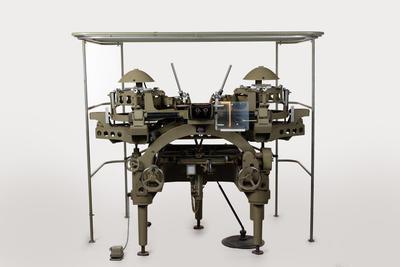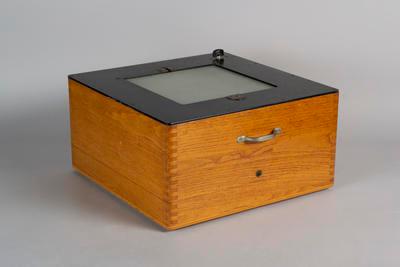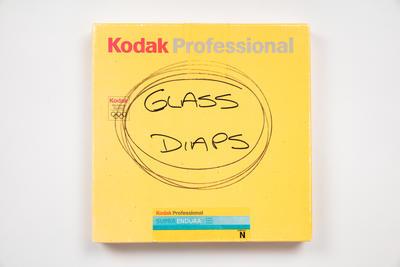Stereoplotter
Maker and role
Wild Heerbrugg Limited, Manufacturer
Production date
Circa 1959
See full details
Object detail
Accession number
2020.9.1
Maker
Production period
Description
Wild Heerbrugg A8 725 Stereoplotter made of cast steel.
Part 1: The green stereoplotter is founded on a U-shaped mainframe with three feet, one at each point. The mainframe can separate from the top elements which form a series of detachable parts.
On either side of the front of the mainframe's base are two silver turning wheels with black handles. The left-hand side also has a smaller turning wheel, placed above the main handle. On the left-hand side of the stereoplotter is a foot pedal attached to the mainframe by a silver cord. Attached to the foot pedal is a maker's plate with the text, "GHIELMETTI & Cie. AG. / SOLOTHURIN SCHWEIZ / A 10 / V 500 / 50 / No. 188117 PO". On the right-hand side is a cylindrical weight held by a chain. On the side of the right-hand foot is two metal ports with “Y / X” engraved next to them in white. On the back of this left-hand leg is a sticker with hand-written text, "L H /.".
On the rear leg is a sticker with the hand-written text, "3 / REAR". Sitting on top of the rear leg is a silver electrical box with a gold sticker which reads, "Electra". Attached to this box are two black cords which run to the lamps above. There are also two white cords, one has a black power plug on one end, the other has a white power plug which is connected to a brown power cord, which runs into the rear of the stereoplotter mainframe.
Sitting across the width of the mainframe is a slide rule which can be slid backwards and forwards using the silver and black handles attached to each leg. Various measurements are placed across this device. A protruding green and black handle allows the device to be adjusted. Attached to rear of this device is a white coiled cord which attaches to the rear of the mainframe. At the front of this part is a viewing plate with a reticle. Attached to the right-hand side of this part is a long black pole which attaches to a black plate which rests on the ground. On the top of the device are two metal poles which are placed vertically in a V-shaped position. These extend into the top half of the stereoplotter.
At the front of the stereoplotter, attached to the mainframe is a large arch which a black maker’s plate which reads, “WILD / HEERBRUGG / Made in Switzerland / A8-7 5”. At the top of this arch is another platform consisting of multiple parts. On each side of the top of the stereoplotter is rounded frame on which a domed lamp overhangs a black plate with a rectangular cut-out. The plate is enclosed with various pieces of metal teeth lined with measurements. At the rear of these circled frames are a series of yellow power cords which attach to various other parts of the stereoplotter. Within each frame is an adjustable lens, and a black chained pulley system. On either side of the frame is two vertical silver measuring rules, and a circular measuring device. At the front of each rounded frame is a small, circular glass lens with “WILD / HEERBURGG / 4X” engraved in white, and an adjustable silver dial.
Beneath each circular frame is a small bellow which connects to a large black tube which runs across the front of the stereoplotter. Beneath the black tube on the left-hand side is a small measuring rule. At the centre of the black tube is an eyepiece, and to the right, a large plastic clipboard, for paper to rest. Behind the eyepiece is a series of three silver bars which can be adjusted with a small crank handle on the right. Various measurements decorate the front tube, the crank handle and two vertical rules. Each vertical rule has a small black lens with “WILD / HEERBURGG / 4X” engraved in white. Two adjustable silver dials sit behind the silver bars.
Part 2: The frame is square in size, with four legs that surround the stereoplotter. There are four rungs along the top and a metal curtain slider along the front half of the frame for a curtain to be hung. The back of the frame forms an ‘X’ shape.
Parts 3 and 4: Two green metal poles with a clamp at either end.
Parts 5 and 6: Two small metal springs with a hook at each end.
Parts 7 and 8: Two small black legs that rotate at the feet.
Part 9:A small piece of spring.
Part 10: A small metal nut.
Part 1: The green stereoplotter is founded on a U-shaped mainframe with three feet, one at each point. The mainframe can separate from the top elements which form a series of detachable parts.
On either side of the front of the mainframe's base are two silver turning wheels with black handles. The left-hand side also has a smaller turning wheel, placed above the main handle. On the left-hand side of the stereoplotter is a foot pedal attached to the mainframe by a silver cord. Attached to the foot pedal is a maker's plate with the text, "GHIELMETTI & Cie. AG. / SOLOTHURIN SCHWEIZ / A 10 / V 500 / 50 / No. 188117 PO". On the right-hand side is a cylindrical weight held by a chain. On the side of the right-hand foot is two metal ports with “Y / X” engraved next to them in white. On the back of this left-hand leg is a sticker with hand-written text, "L H /.".
On the rear leg is a sticker with the hand-written text, "3 / REAR". Sitting on top of the rear leg is a silver electrical box with a gold sticker which reads, "Electra". Attached to this box are two black cords which run to the lamps above. There are also two white cords, one has a black power plug on one end, the other has a white power plug which is connected to a brown power cord, which runs into the rear of the stereoplotter mainframe.
Sitting across the width of the mainframe is a slide rule which can be slid backwards and forwards using the silver and black handles attached to each leg. Various measurements are placed across this device. A protruding green and black handle allows the device to be adjusted. Attached to rear of this device is a white coiled cord which attaches to the rear of the mainframe. At the front of this part is a viewing plate with a reticle. Attached to the right-hand side of this part is a long black pole which attaches to a black plate which rests on the ground. On the top of the device are two metal poles which are placed vertically in a V-shaped position. These extend into the top half of the stereoplotter.
At the front of the stereoplotter, attached to the mainframe is a large arch which a black maker’s plate which reads, “WILD / HEERBRUGG / Made in Switzerland / A8-7 5”. At the top of this arch is another platform consisting of multiple parts. On each side of the top of the stereoplotter is rounded frame on which a domed lamp overhangs a black plate with a rectangular cut-out. The plate is enclosed with various pieces of metal teeth lined with measurements. At the rear of these circled frames are a series of yellow power cords which attach to various other parts of the stereoplotter. Within each frame is an adjustable lens, and a black chained pulley system. On either side of the frame is two vertical silver measuring rules, and a circular measuring device. At the front of each rounded frame is a small, circular glass lens with “WILD / HEERBURGG / 4X” engraved in white, and an adjustable silver dial.
Beneath each circular frame is a small bellow which connects to a large black tube which runs across the front of the stereoplotter. Beneath the black tube on the left-hand side is a small measuring rule. At the centre of the black tube is an eyepiece, and to the right, a large plastic clipboard, for paper to rest. Behind the eyepiece is a series of three silver bars which can be adjusted with a small crank handle on the right. Various measurements decorate the front tube, the crank handle and two vertical rules. Each vertical rule has a small black lens with “WILD / HEERBURGG / 4X” engraved in white. Two adjustable silver dials sit behind the silver bars.
Part 2: The frame is square in size, with four legs that surround the stereoplotter. There are four rungs along the top and a metal curtain slider along the front half of the frame for a curtain to be hung. The back of the frame forms an ‘X’ shape.
Parts 3 and 4: Two green metal poles with a clamp at either end.
Parts 5 and 6: Two small metal springs with a hook at each end.
Parts 7 and 8: Two small black legs that rotate at the feet.
Part 9:A small piece of spring.
Part 10: A small metal nut.
Brief History
This Wild A8 photogrammetric stereoplotter, along with two others, was bought by New Zealand Aerial Mapping (NZAM) from the Swiss manufacturers, Wild Heerbrugg, in 1959. The A8 was newly designed and a distinct improvement in speed and accuracy on NZAM’s aging Multiplex stereoplotters. Stereoplotters were used in converting the aerial survey photographs taken by NZAM’s planes into topographical maps. By 1962 the entire North Island and large areas of the South Island had been mapped via this method. The science underlying this process is known as photogrammetry, that is, making measurements from photographs.
Marks
GHIELMETTI & Cie. AG. / SOLOTHURIN SCHWEIZ / A 10 / V 500 / 50 / No. 188117 PO Maker's Mark
Y / X Engraved
L H /. Sticker
3 / REAR Sticker
Electra Sticker
WILD / HEERBRUGG / Made in Switzerland / A8-7 5 Maker's Plate
WILD / HEERBURGG / 4X Engraved
Y / X Engraved
L H /. Sticker
3 / REAR Sticker
Electra Sticker
WILD / HEERBRUGG / Made in Switzerland / A8-7 5 Maker's Plate
WILD / HEERBURGG / 4X Engraved
Media/Materials
Other name
Stereo plotter
Collection
Credit Line
Wild Heerbrugg Limited. Circa 1959. Stereoplotter, 2020.9.1. The Museum of Transport and Technology (MOTAT).
On display?
On display


![Aircraft [Beechcraft AT-11 Kansan ZK-AHO]; Beech Aircraft Corporation; New Zealand Aerial Mapping Limited; 1942](https://collection.motat.nz/records/images/medium/54153/220c319ae0475ddf270b2371b0374a9e90459e50.jpg)
![Gear Set [Wild Heerbrugg A8 725 Stereoplotter]; Wild Heerbrugg Limited](https://collection.motat.nz/records/images/medium/52889/ad13c59a62e04390dd23c6cc9dc11f0cac60a776.jpg)
![Gear Set [Wild Heerbrugg A8 725 Stereoplotter]; Wild Heerbrugg Limited](https://collection.motat.nz/records/images/medium/52885/3670a12ef8f1044450ad5f88667e119fda0f8aab.jpg)


Public comments
Be the first to comment on this object record.